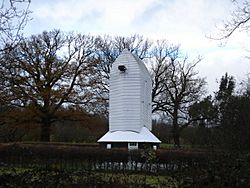Lowfield Heath Windmill facts for kids
Quick facts for kids Lowfield Heath Mill |
|
|---|---|

Lowfield Heath Windmill without sails
|
|
| Origin | |
| Mill name | Lowfield Heath Mill |
| Mill location | TQ 2347 4072 |
| Coordinates | 51°09′09″N 0°14′10″W / 51.1524°N 0.2360°W |
| Operator(s) | Lowfield Heath Windmill Trust |
| Year built | 1989 |
| Information | |
| Purpose | Corn mill |
| Type | Post mill |
| Roundhouse storeys | Single storey roundhouse |
| No. of sails | Four sails |
| Type of sails | patent sails, common sails |
| Windshaft | Cast iron |
| Winding | Tailpole |
| No. of pairs of millstones | Two pairs, Head and Tail |
The Lowfield Heath Windmill is a special old windmill located in Charlwood, Surrey, England. It is a "grade II listed" building, which means it's an important historical structure that is protected. This type of windmill is called a post mill, and it has been carefully restored so it can work again!
Contents
History of Lowfield Heath Windmill
Early Days and Location Changes
The Lowfield Heath Windmill was first built in a place called Lowfield Heath. We don't know exactly when it was built, but it shows up on maps from the 1760s onwards. There were some rumors that it was moved from other towns like Hookwood or Horsham, but there's no real proof of that.
In 1827, the miller (the person who ran the mill) tried to stop the common land around the mill from being fenced off, but he wasn't successful. The mill was also damaged in a big storm on November 29, 1835.
When the Windmill Stopped Working
The windmill stopped using wind power in 1880. After that, it was powered by a portable steam engine until at least 1895. By the 1930s, the mill had fake sails that were much smaller than the real ones.
By 1957, the windmill was in very bad shape. Its roundhouse roof was gone, and most of its main roof was missing. People started doing work to protect the mill in 1964, and more repairs happened between 1965 and 1971.
Moving and Restoring the Windmill
In 1984, a special group called a Trust was formed. Their goal was to restore the windmill. However, there were problems with getting to the mill, and people worried it might be knocked down because Gatwick Airport was getting bigger.
So, they decided to move the entire windmill to a new spot next to Gatwick Zoo. They started taking the mill apart in June 1987. By September, the old site at Lowfield Heath was empty.
Rebuilding the windmill began in 1988. The main frame (called the trestle) and the roundhouse were put back together. The mill itself was rebuilt during the summer of 1989. On April 10, 1990, Princess Alexandra officially opened the restored windmill. The roundhouse was fully finished in 1991.
Bringing the Mill Back to Life
In 1997, work started to make the mill fully operational again. The mill uses large stones called millstones to grind grain. Some of the original millstones were missing, but they found one and got another from a different collapsed mill.
They also built a new sack hoist (a machine to lift sacks of grain) and fitted new sails. The restored mill turned by wind for the first time on June 26, 1998!
The zoo next to the mill closed in 2001, and houses were built there. However, the 2-acre plot of land where the windmill stands was left untouched. In 2003, a storm damaged the sails, and new ones were fitted.
The restoration of the mill was paid for by many groups, including the Heritage Lottery Fund, the Science Museum, and Gatwick Airport.
How Lowfield Heath Windmill Works
The Lowfield Heath Windmill is a "post mill." This means the entire top part of the mill, which holds the machinery and sails, can turn on a large central post. This allows the mill to face the wind from any direction. It has a single-story roundhouse at its base.
The mill uses a "tailpole" to turn its body to face the wind. It originally had four "Common sails," which are simpler sails. Later, it used four "Patent sails," which are more advanced and can adjust automatically to the wind. Today, the mill has one pair of Patent sails and one pair of Common sails.
Inside, the mill has a cast iron "windshaft" that connects the sails to the grinding machinery. It drives two pairs of millstones, which are large, heavy stones that grind corn into flour.
Millers of Lowfield Heath Windmill
Here are some of the people who operated the Lowfield Heath Windmill over the years:
- Parker (1827)
- William and Charles Constable (1842)
- John Ansell (1848-1880)
- Joseph Henry Robinson (1882–1895)
Visiting the Windmill
You can visit the Lowfield Heath Windmill! It is usually open on the last Sunday of each month. It also opens for special events like National Mills Day and the Heritage Open Weekend.

